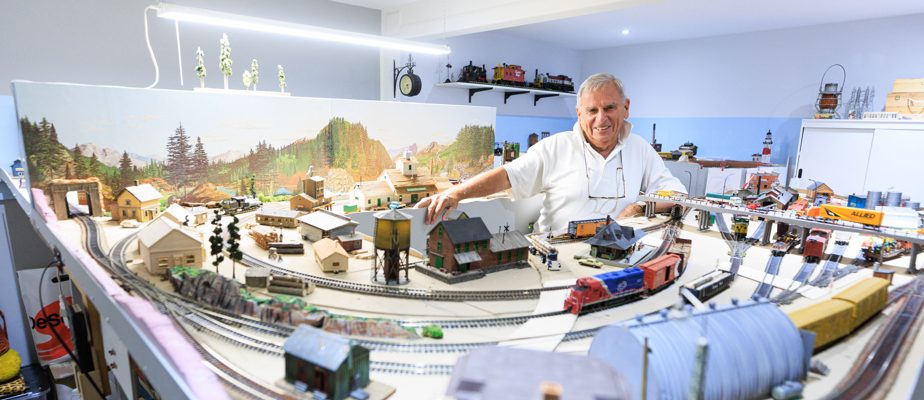As soon as the moving boxes were emptied, Pierre Laruelle wasted no time in tearing down a partition in his new house to set up his personal playground: a room entirely devoted to his passion for model railroading.
The scene is worthy of a making of of a special effects film: in the center of a rural landscape the size of two bedrooms, the railroader from Saint-Jérôme looks like a giant when he lifts miniature locomotives and wagons for lay out on railroads.
All around it run countless serpentine railway lines.
The meticulous placement of the trains instills a pleasant feeling of pleasure in the room, which, at the onset of the soft sound of idling diesels, rises to the level of excitement.
Digital controls in hand, Mr. Laruelle gently launches the machines into a row of rails, switches and level crossings. He directs them through town and countryside to a station or seaport, located at the other end of the room, where the passengers can get off and where the goods will be unloaded. From there, the trains will take the marshalling track or that of a huge rotunda garage.
All this in a playful atmosphere of bells and flashing signals.

PHOTO HUGO-SÉBASTIEN AUBERT, THE PRESS
In his house, Pierre Laruelle has a room entirely devoted to his passion for model railroading.
In the middle of this bluffing decor, a 78-year-old man displays the smile of a real kid. “It’s not for children!” “, however, retorts Mr. Laruelle to all those who reduce this leisure to childish games. “The idea behind it all isn’t just to run trains. That’s all there is around. It is to devote oneself to creating a perfect illusion, like in the cinema. »

PHOTO HUGO-SÉBASTIEN AUBERT, THE PRESS
For the magic of miniature realism to work, there needs to be real craftsmanship behind it.
A work of craftsman
However, the magic of miniature realism cannot operate without a good mastery of the visual arts, cabinetmaking, computer science, electrical engineering and history, adds this former artistic director of the CJMS radio station and Jean Coutu pharmacies.
“I spend time on YouTube! he laughs, installed in his workshop well equipped with soldering irons, fine pliers, electronics screwdriver, brushes, special drill and table saw the size of a small coffee maker.
-

PHOTO HUGO-SÉBASTIEN AUBERT, THE PRESS
Each car and locomotive is hand painted to the specifications of the respective companies.
-

PHOTO HUGO-SÉBASTIEN AUBERT, THE PRESS
Caution: passing train!
-

PHOTO HUGO-SÉBASTIEN AUBERT, THE PRESS
The model must respect a perfect scaling.
-

PHOTO HUGO-SÉBASTIEN AUBERT, THE PRESS
Mr. Laruelle’s miniature railway village occupies the size of two bedrooms.
1/4
Within arm’s reach, its library is full of technical documentation on the various machines used over time by Canadian Pacific and Canadian National. Each car and locomotive is hand painted to the specifications of the respective companies. ” Look at ! The white lines should be 4mm and the black lines 5mm,” he points out, pointing to the alternating hatched lines at the back of a locomotive.
“Everything you create on the model has to respect perfect scaling. You can just buy ready-made buildings on the internet. But if you really want to have fun, you can also build the universe that looks like you,” he says in front of a replica of a typical mid-20th century CP station.e century.
“It was in a station like this that I worked, in the Laurentians, as a train attendant when I was a student,” says Mr. Laruelle, his eyes shining.

PHOTO HUGO-SÉBASTIEN AUBERT, THE PRESS
Mr. Laruelle’s love affair with trains goes back a long way.
A love story
Pierre Laruelle’s attraction to trains is not accidental, even less innocuous. His life, in fact, is punctuated with railway anecdotes.
“I was born in Saint-Eugène-de-Grantham station, where my uncle was station master. As my father left for the war shortly before I was born, my uncle offered my mother to live on the second floor of the station. I grew up surrounded by the noise of trains,” he says.
After his demobilization, Gabriel Laruelle attempted a return to civilian life before returning to uniform. He joined a body of engineers specializing in electronics, based in Longue-Pointe. His free time was spent building a chalet in Nominingue, in the Laurentians, where he also built a huge railway circuit.
“In Europe, my father had traveled a lot by train. It was part of his life. At the chalet, we built an outdoor model of 75 feet by 100 feet,” he recalls, looking at the magnificent English locomotive displayed on a shelf. “It was his. »
In the mid-1960s, during his student years, Pierre Laruelle worked as a trainman for Canadian Pacific for a few summers.
“I was sent to the Northern line, between Jean-Talon station and Mont-Laurier, and to the Montreal-Ottawa line,” he says, his head still full of nights spent on the benches, reports in 14 copies typed with one finger and railway workers as generous as they are hard at work.
Since that time, trains have remained an object of fascination for Mr. Laruelle. To him, they are marvels of engineering and design, as evidenced by the sublime photos and illustrations hung in his home. But the origin of his passion is summed up in a logo of a fictitious company, painted on a locomotive: GP Rail.
“These are our initials, to my father and me”, he slips, simply.
Calling all
Do you have a favorite room in your home that is out of the ordinary and that you would like to show off? Write to our collaborator to let him know.
